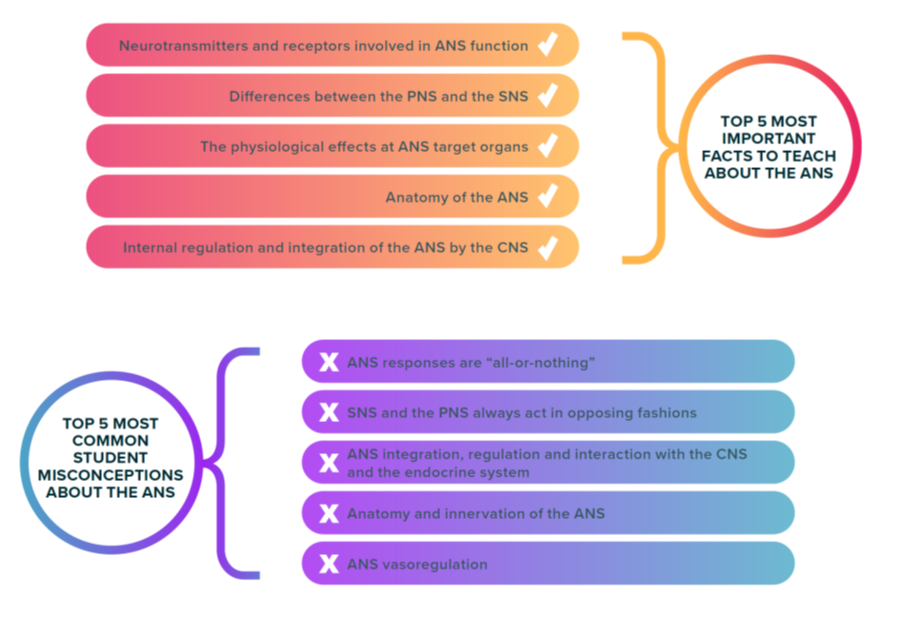Autonomic Nervous System Learning Module
Author
 Susan Barman, PhD, FAPS
Susan Barman, PhD, FAPS
Michigan State University, East Lansing
The autonomic nervous system (ANS) is critical for the integration and regulation of physiological systems. When surveyed, American Physiological Society members identified key facts and misconceptions that should be addressed when teaching the ANS.

This learning module provides an essential framework for understanding the ANS by addressing these key facts, misconceptions and core concepts in physiology relevant to the ANS. In response to the aforementioned survey, the following learning objectives were outlined for this learning module:
- describe the three divisions of the ANS, the organs innervated and the physiological processes regulated by the ANS;
- explain the integrative nature of the ANS by giving examples of responses involving multiple organ systems;
- recognize the importance of negative feedback loops in homeostasis;
- describe the anatomical differences in nerve fiber type, preganglionic nerve length and postganglionic nerve length between sympathetic and parasympathetic nervous systems;
- identify the subtypes, locations and actions of cholinergic and adrenergic receptors;
- predict how pharmacological blockade of cholinergic and adrenergic receptors would alter physiological responses;
- critique the overgeneralization of “fight or flight” and “rest and digest” as the main roles of the sympathetic and parasympathetic nervous systems, respectively;
- explain the difference between the three tissue innervation patterns of parasympathetic and sympathetic nerves: physiological antagonists (dual innervation/opposite effects), physiological agonists (dual innervation/complementary effects) and single innervation;
- identify the stimulus, sensor, afferent neural pathway, central brain region, efferent neural pathway, effector organ(s), and corrective physiological responses; and
- describe and integrate three physiological responses from different organ systems mediated by the autonomic nervous system that occur in response to both exercise and stress, respectively.
BONUS FEATURE
Autonomic Nervous System Focus on Comparative Physiology
Author
 Jessica Rippamonti Mays, MSc
Jessica Rippamonti Mays, MSc
University of North Texas, Denton
An explanation of autonomic control of thermoregulation in birds and mammals provides a comparative physiologist’s perspective of the ANS.

Autonomic Nervous System


Autonomic Neuroscience
- Autonomic Nervous System—Explore the autonomic nervous system (ANS), its divisions (sympathetic & parasympathetic), key neurotransmitters, and CNS control. Dive into how the ANS governs diverse functions from heartbeat to digestion.
Resources to Explore
Overview of the Autonomic Nervous System
Find foundational information about the autonomic nervous system (ANS) and the physiological effects of ANS activation.
Overview of the Anatomy, Physiology, and Pharmacology of the Autonomic Nervous System
Wehrwein E.A., et al., Comprehensive Physiology,
2016
An Introduction into Autonomic Nervous Function
Karemaker J.M., Physiological Measurement, 2017
Physiology of the Autonomic Nervous System
McCorry L.K., American Journal of Pharmaceutical Education, 2007
The Multibranched Nerve: Vagal Function Beyond Heart Rate Variability
Karemaker J.M., Biological Psychology,
2022
Electroceutical Targeting of the Autonomic Nervous System
Horn C.C., et al., Physiology, 2019
Sympathetic Innervation of White Adipose Tissue: to Beige or Not to Beige?
Münzberg H., et al., Physiology,
2021
Sex-steroid-dependent Plasticity of Brain-stem Autonomic Circuits
Littlejohn E.L., et al., Regulatory, Integrative and Comparative Physiology,
2020
Impact of the Autonomic Nervous System on the Skeleton
Elefteriou F., Physiological Reviews, 2018
Challenges to the Central Nervous System During Human Spaceflight Missions to Mars
Clément G.R., et al.,
Journal of Neurophysiology, 2020
Engineering Human Stasis for Long-Duration Spaceflight
Nordeen C.A., Martin S.L., Physiology, 2019
Endocrine-Autonomic Linkages
Sladek C.D., et al., Comprehensive Physiology, 2015
Function of Renal Nerves in Kidney Physiology and Pathophysiology
Osborn J.W., et al., Annual Review of Physiology,
2021
Interactions between the Autonomic Nervous System and the Immune System after Stroke
Zhu L., et al., Comprehensive Physiology,
2022
Targeting Parasympathetic Activity to Improve Autonomic Tone and Clinical Outcomes
Kay M.W., et al., Physiology,
2022
NCCSTS Case Collection (formerly National Center for Case Study Teaching in Science at University of Buffalo)
National
Science Teaching Association (NSTA), 2022
Autonomic Nervous System
Klabunde R.E., Cardiovascular Pharmacology Concepts, 2008
Autonomic Ganglia
Klabunde R.E., Cardiovascular Pharmacology Concepts, 2018
Drugs of the Autonomic Nervous System: Practice Questions
Elker A., University
of Nebraska Medical Center (UNMC), 2017
Autonomic Nervous System
Cleveland Clinic, 2022
Physiology Experiments
Monash University, 2022
Cardiovascular Experiments
Monash University, 2022
Cardiac Muscle Experiments
Monash University, 2022
Gastrointestinal Smooth Muscle Experiments
Monash University, 2022
Physiology Puzzles
Monash University, 2022
Are You Thirsty? Here’s Why.
Zinkevich N., APS I Spy Physiology Blog, 2021
Yoga + Deep Breathing = A Calmer You
Vasauskas A.A., APS I Spy Physiology Blog, 2017
Understand the Relationship between the ANS and Cardiovascular Function
Investigate how activation of the ANS affects cardiovascular function.
Sympathetic and Sensory-motor Nerves in Peripheral Small Arteries
Aalkjær C., et al., Physiological Reviews,
2021
Interpretation of Heart Rate Variability: The Art of Looking Through a Keyhole
Karemaker J.M., Frontiers in Neuroscience,
2020
Neural Control of Cardiovascular Function in Black Adults: Implications for Racial Differences in Autonomic Regulation
Drew
R.C., et al., American Journal of Physiology-Regulatory, Integrative and Comparative Physiology, 2020
Novel Approaches to Restore Parasympathetic Activity to the Heart in Cardiorespiratory Diseases
Dyavanapalli
J., American Journal of Physiology-Heart and Circulatory Physiology, 2020
2019 Ludwig Lecture: Rhythms in Sympathetic Nerve Activity are a Key to Understanding Neural Control of the Cardiovascular System
Barman
S.M., American Journal of Physiology-Regulatory, Integrative and Comparative Physiology, 2020
Neural Control of the Circulation: How Sex and Age Differences Interact in Humans
Joyner M.J., et al., Comprehensive Physiology,
2015
Sympathetic Neural Activity to the Cardiovascular System: Integrator of Systemic Physiology and Interindividual Characteristics
Charkoudian
N., Wallin B.G., Comprehensive Physiology, 2014
Sympathetic Nervous System Overactivity and Its Role in the Development of Cardiovascular Disease
Malpas S.C.,
Physiological Reviews, 2010
Lower Body Negative Pressure: Physiological Effects, Applications, and Implementation
Goswami N., et al.,
Physiological Reviews, 2018
Syncopedia.org
Syncopedia Foundation, 2022
Cold Stress and the Cold Pressor Test
Silverthorn D.U., Michael J., Sourcebook of Laboratory Activities in Physiology,
Advances in Physiology Education, 2013
The Impact of Deep Breathing and Alternate Nostril Breathing on Heart Rate Variability: A Human Physiology Laboratory
Levin
C.J., Swoap S.J., Sourcebook of Laboratory Activities in Physiology, Advances in Physiology Education, 2019
Investigating Autonomic Control of the Cardiovascular System: A Battery of Simple Tests
Johnson C.D., et al.,
Sourcebook of Laboratory Activities in Physiology, Advances in Physiology Education, 2013
Autonomic Innervation of the Heart and Vasculature
Klabunde R.E., Cardiovascular Physiology Concepts, 2016
NCCSTS Case Collection (formerly National Center for Case Study Teaching in Science at University of Buffalo)
National
Science Teaching Association (NSTA), 2022
Cardiovascular Experiments
Monash University, 2022
Cardiac Muscle Experiments
Monash University, 2022
Hypertension: Silent and Unequal
Somani Y., APS I Spy Physiology Blog, 2018
Want to Lower Your Blood Pressure? Just Breathe (In)
Watso J.C., APS I Spy Physiology
Blog, 2021
Fainting, the Brain and the Chilean Miners’ Rescue
Dias K., APS I Spy Physiology
Blog, 2020
Teach the Mammalian Diving Response
Facilitate student understanding of integrative physiology through investigation of the mammalian diving response—a unique ANS response.
The Mammalian Diving Response: An Enigmatic Reflex to Preserve Life?
Panneton W.M., Physiology, 2013
Edmund Goodwyn and the First Description of Diving Bradycardia
Vega J.L., Journal of Applied Physiology, 2017
Vascular Responses to Simulated Breath-hold Diving Involving Multiple Reflexes
Fico B.G., et al., American Journal of Physiology-Regulatory, Integrative and Comparative Physiology, 2022
Using Stimulation of the Diving Reflex in Humans to Teach Integrative Physiology
Choate J.L., et al., Sourcebook of Laboratory Activities in Physiology, Advances in Physiology Education, 2014
Stimulated Human Diving and Heart: Making the Most of the Diving Response as a Laboratory Exercise
Hiebert S.M., Burch E., Advances in Physiology Education, 2003
Can You Win an Underwater Breath-holding Competition?
Olsen G., APS I Spy Physiology Blog, 2021
Learn about the ANS and Thermoregulation
Explore the role of the ANS in homeostasis and maintaining a stable body temperature.
Human Temperature Regulation Under Heat Stress in Health, Disease, and Injury
Cramer M.N., et al., Physiological Reviews,
2022
Regulation of Body Temperature by the Nervous System
Tan C.L., Knight Z.A., Neuron, 2018
The Physiology of Heat Tolerance in Small Endotherms
McKechnie A.E., Wolf B.O., Physiology, 2019
Sex Differences in Human Thermoregulation: Relevance for 2020 and Beyond
Yanovich R., et al., Physiology,
2020
Sympathetic Control of Reflex Cutaneous Vasoconstriction in Human Aging
Greaney J.L., et al., Journal of Applied Physiology,
2015
Adaptation to Heat and Water Shortage in Large, Arid-Zone Mammals
Fuller A., et al., Physiology,
2014
Integrating Competing Demands of Osmoregulatory and Thermoregulatory Homeostasis
McKinley M.J., et al., Physiology,
2018
Human Cardiovascular Responses to Passive Heat Stress
Crandall C.G., Wilson T.E., Comprehensive Physiology,
2015
Integrated Physiological Mechanisms of Exercise Performance, Adaptation, and Maladaptation to Heat Stress
Sawka M.N.,
et al., Comprehensive Physiology, 2011
Thermoregulatory Responses to Acute Exercise-Heat Stress and Heat Acclimation
Sawka M.N., et al., Comprehensive Physiology,
2011
Human Thermoregulatory Responses to Acute Cold Stress with Special Reference to Water Immersion
Toner M.M., McArdle
W.D., Comprehensive Physiology, 2011
Cardiovascular Adjustments to Thermal Stress
Rowell L.B., Comprehensive Physiology, 2011
The Sympathetic Release Test: a Test Used to Assess Thermoregulation and Autonomic Control of Blood Flow
Tansey E.A., et al., Sourcebook of Laboratory Activities in Physiology, Advances in Physiology Education, 2014
NCCSTS Case Collection (formerly National Center for Case Study Teaching in Science at University of Buffalo)
National Science Teaching Association (NSTA), 2022
Some Like It Hot
Sell M., The Physiologist Magazine, 2022
Turning Up the Heat: Enjoying Summer When You’re Pregnant
Mellott E., APS I Spy Physiology Blog, 2022
Beat the Heat with a Wet T-Shirt
Roth E., APS I Spy Physiology Blog, 2020
Understand the ANS’ Role in Stress
Browse resources that explain how and when the ANS coordinates a response to stress.
Sympathetic Neural Control in Humans with Anxiety-Related Disorders
Bigalke J.A., Carter J.R., Comprehensive Physiology, 2022
Sympathoneural and Adrenomedullary Responses to Mental Stress
Carter J.R., Goldstein D.S., Comprehensive Physiology, 2015
Regulation of the Hypothalamic-Pituitary-Adrenocortical Stress Response
Herman J.P., et al., Comprehensive Physiology, 2016
Circulating Catecholamines
Klabunde R.E., Cardiovascular Physiology Concepts, 2016
Who's the Boss: Determining the Control Pathways of Cardiovascular and Cellular Immune Responses to Acute Stress
Edwards K.M., Morris N.B., Sourcebook of Laboratory Activities in Physiology, Advances in Physiology Education, 2018
The Healing Power of Nature
Wehrwein E.A., APS I Spy Physiology Blog, 2020
Healing the Physical and Metaphorical Heart
Edwards C., APS I Spy Physiology Blog, 2022
Post-traumatic Stress Disorder: 1 Part Genes, 1 Part Experience
Cioffi D., APS I Spy Physiology Blog, 2018
Relieve Stress and Anxiety with Exercise in the New Year
Farquhar W.B., APS I Spy Physiology Blog, 2018
The Power of Gratitude to Improve Mental and Physical Wellness
Wehrwein E.A., APS I Spy Physiology Blog, 2020
Investigate the Effects of the ANS in Exercise
Learn how the ANS mediates the body’s response to exercise.
Neural Control of the Circulation: How Sex and Age Differences Interact in Humans
Joyner M.J., et al., Comprehensive Physiology, 2015
Reflexes Controlling Circulatory, Ventilatory and Airway Responses to Exercise
Kaufman M.P., Forster H.V., Comprehensive Physiology, 2011
Integration of Cardiovascular Control Systems in Dynamic Exercise
Rowell L.B., et al., Comprehensive Physiology, 2011
Autonomic Adjustments to Exercise in Humans
Fisher J.P., et al., Comprehensive Physiology, 2015
Integration of Central and Peripheral Regulation of the Circulation during Exercise: Acute and Chronic Adaptations
Mueller P.J., et al., Comprehensive Physiology, 2018
Regulation of Increased Blood Flow (Hyperemia) to Muscles During Exercise: A Hierarchy of Competing Physiological Needs
Joyner M.J., Casey D.P., Physiological Reviews, 2015
Cardiac Vagus and Exercise
Gourine A.V., Ackland G.L., Physiology, 2018
Skeletal Muscle Blood Flow
Klabunde R.E., Cardiovascular Physiology Concepts, 2020
Active Hyperemia
Klabunde R.E., Cardiovascular Physiology Concepts, 2007
Brachial Artery Blood Flow by Vascular Ultrasound in Education
Jamison J.P., et al., Sourcebook of Laboratory Activities in Physiology, Advances in Physiology Education, 2022
Sleeping on an Airplane: It’s All about Blood Flow
Ho D.H., APS I Spy Physiology Blog, 2019
Walk It Out: How Frequent Walking Breaks Help Your Brain
Carter S., APS I Spy Physiology Blog, 2018
Explore the Center
Themes and Resources
- Evidence-based Teaching Practices
- Inclusive Teaching
- Teaching and Learning Integrative Physiology
- Physiology Education Research
- Curriculum Development
Community Events
Share your event ideas
More from the Center
- Center Home
- About the Center
- Support the Center
- Meet the Advisory Board
- Interactive Content from Center Partners
- Signup for Announcements
- Advances in Physiology Education
- Be a Champion for the Center
- Solutions for Educators
Volunteer
#CenterForPhysiologyEd
Autonomic Nervous System Group
 Adele Denison, PhD
Adele Denison, PhD
Michigan State University, East Lansing
 Anthony Paganini, PhD
Anthony Paganini, PhD
Michigan State University, East Lansing
 Bob Stephenson, PhD
Bob Stephenson, PhD
Michigan State University, East Lansing
 Erica Wehrwein, PhD
Erica Wehrwein, PhD
Michigan State University, East Lansing




